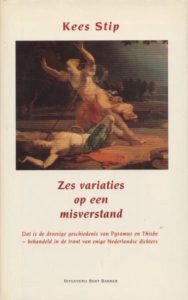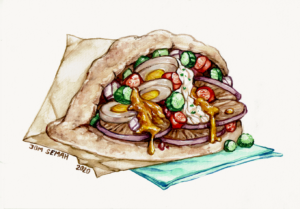Woerden overstappen! De geniale slotregels van Kees Stip
 Marten Faber was een van de godfathers van de Nederlandse reclame. Heel copywritend Nederland sidderde als hij zijn stem verhief, bijvoorbeeld zoals hij weer eens deed in De wellustige streling van kamerbrede behaaglijkheid, een nieuwjaarsgeschenk voor relaties van Van Dale Lexicografie over reclame en taal. Faber leverde voor dat boekje een bijdrage met als titel de retorische vraag ‘Kunnen tekstschrijvers wel schrijven?’ en nam zichzelf als voorbeeld. Niet ten onrechte, zoals zal blijken.
Marten Faber was een van de godfathers van de Nederlandse reclame. Heel copywritend Nederland sidderde als hij zijn stem verhief, bijvoorbeeld zoals hij weer eens deed in De wellustige streling van kamerbrede behaaglijkheid, een nieuwjaarsgeschenk voor relaties van Van Dale Lexicografie over reclame en taal. Faber leverde voor dat boekje een bijdrage met als titel de retorische vraag ‘Kunnen tekstschrijvers wel schrijven?’ en nam zichzelf als voorbeeld. Niet ten onrechte, zoals zal blijken.
Hij verhaalt in dat stuk hoe hij ooit voor een farmaceutisch bedrijf twintig weken lang een mailing voorzag van ‘versjes à la Trijntje Fop’. Ongehinderd door gêne citeert hij het volgende vers van zijn hand:
Op een pancreas
Een oude pancreas uit Heze
kon niet zo bijsterbest meer lezen.
Toen hij dus eens te Sint Pancras
zijn bijna-naam op ‘t bordje las,
sprak hij geroerd: ‘Aanschouw thans hier
de eerste heilige oude klier!’
Daarna klaagt hij huilerig: ‘Wat ben ik minder dan die hoogst overschatte hermafrodiet Trijntje/Kees-Fop/Stip? Dat mag maar raak bundelen. En ik?’ Het antwoord op de vraag ‘Wat ben ik minder?’ is kort: ongeveer alles. De zes regels rijmen, maar alleen voor wie niet aan metrum hecht, de derde regel met een verkeerde klemtoon eindigt en de laatste regel als ‘de eerste heil’ge oude klier’ leest.
Onoverkomelijker is dat Faber zijn rijmpje afrondt met een regel waaraan letterlijk niets geestigs te ontdekken valt. Hij doet niets met het kernwoord klier. Het Nederlands kent niet de uitdrukkingen eerste klier, heilige of oude klier. De enige vaste combinatie is ‘vervelende klier’ en die blijft ongebruikt. Zelfs Neerlands oudste grap – ‘Dokter, ik heb een klier die niet werkt.’ ‘Ach, mevrouw, ik heb ook een zoon in 4-Havo.’ – zien we hier niet terug. Faber produceert geen pointe, geen frappe, geen woordspeling, geen gedachtenkronkel.
De arrogantie die hij tentoonspreidt – en daarna zelf logenstraft –, is typerend voor het dedain waarmee het werk van Stip lang bezien is. Versjes van in doorsnee 6 regels, rijmend volgens het schema a-a b-b c-c, over een mus, een koe, een wesp: dat moet niet moeilijk zijn.
Dat vindt overigens niet iedereen. Battus wijdde een van zijn artikelen over nonsensdichters aan Stip (Vrij Nederland, 22 augustus 1981). Hij noemt hem, in verband met het dierdicht, ‘de grootmeester van het genre’ en wat verder heeft hij het over ‘een geniaal dichter’. Drs. P vermeldt in het Handboek voor Plezierdichters ‘de brillante Kees Stip’.
Een nadere analyse van die ogenschijnlijk eenvoudige dierdichten leert, dat het geniale en brillante van Stip met name blijkt in de slotregel, en dat hij daarvoor ruwweg drie procedés hanteert. Voor een deel exploiteert Stip bestaande uitdrukkingen. Zijn bekendste Fop, bijvoorbeeld, ‘Op een made’, eindigt met ‘Er zijn hier heel wat maden bij, die made zijn in Germanij’. Minder geciteerd, maar zeker zo geslaagd is
Op een woerd
‘Den Haag,’ zo zegt een woerd, ‘is blijkbaar
per trein uit Utrecht onbereikbaar.
Want telkens als ik het probeer,
begint een goudgebiesde heer
zijn longen vol met lucht te happen
en roept dan: “Woerden overstappen!”’
Een tweede aanpak is het maken van grappen (met uitzondering van woordspelingen), zoals in
Op een brilslang
Een dikke brilslang zat parterre
vooraan in de Folies-Bergère.
‘Van allerhande euvelen’
– zo hoorde men hem keuvelen –
‘plaagt de bijziendheid mij het meest.
Zijn er al doelpunten geweest?’
De grootste vaardigheid toont Stip in het maken van woordspelingen; niet voor niets heeft hij jarenlang teksten geleverd voor Wim Kans conferences. Het vindingrijkst toont hij zich in slotregels waarin hij twee of drie woorden naadloos tot één vondst aaneensmeedt. Zo creëert hij moeiteloos het bloemetjesbehangbuikzwijntje, de zomerpostzeeëgel, woestijnzandbakkebaarden en de moeraskikvorsmajeur. Bijzonder knap is het vers over twee Russische partijbonzen (‘twee reeds lang ontvleesde zwijnen’), wier eerherstel gevangen wordt in het woord ‘reïntercarbonationale’. De meesterproef legt Stip naar mijn oordeel af met
Op een zeeroos
Een zwarte zeeroos aan de Zaan
was uiterst anemonomaan.
Het beest zat bij de psychiater
en wachtte tot het onder water
weer zeeneurozengeur zou zijn
en anemonomaneschijn.
Hoe lichtvaardig Faber denkt over het maken van ‘versjes à la Trijntje Fop’, moge ook blijken uit het feit dat niemand het Stip op vergelijkbaar niveau heeft nagedaan. Tot Ivo de Wijs – ook een groot bewonderaar van Stip – voor het zondagochtendprogramma Vroege Vogels met grote spitsvondigheid versjes ging schrijven over vogels en andere dieren. Die zijn bijeengebracht in diverse Vroege Vogels-bundels, met name Vroege vogel. Nieuwe en oude verzen uit het Varaprogramma ’Vroege vogels’ (Amsterdam, 1999) en Vroege vogels’ Zwanezang. Verzen uit het Vara-programma Vroege vogels (2003-2005) (Amsterdam, 2005).
Ze verrijkten onze literaire fauna met onder meer de duizenden-één-nachtegalen, gruttogrut, Biesbosbosbesbeestjes en het tweetal uit
Sperweruil en kerkuil
Uit mijn zelfgegraven werkkuil
Keek ik naar de partnerruil
van een Lekkerkerkerkerkuil
en een Weespersperweruil
Ook leuk, deze voor de meester zelf:
Op een muis
Voor Kees Stip
Een muizenman uit Chippendale
Was als erkend transseksueel
Intens bewerkt met siliconen
En vrouwelijke muishormonen
‘Als alles lukt,’ zo sprak dit type,
‘Dan zal ik straks wel anders piepen’
Inmiddels heeft Kees Stip de erkenning gekregen die hem toekomt: hij is opgenomen in de poëziecanon – i.c. de ‘dikke Komrij’ en De Spiegel van de Nederlandse poëzie) – en de enige literaire prijs voor light verse in Nederland, de Tweede Ronde-prijs, werd in 1985 als eerste aan hem toegekend en vervolgens omgedoopt in de Kees Stip-prijs. In Het Grote Beestenfeest. De beste Trijntje Fops aller tijden (Amsterdam, 1988) zijn 615 Foppen bijeengebracht en in Mag ik uw muze even lenen? (Amsterdam, 1989) alle parodieën. Stip dankt zijn populariteit immers, naast de Foppen, aan enkele pastiches, met name aan Dieuwertje Diekema, Een Lied in Dertig Verzen Waar Geen Woord Spaansch bij Is (1945), Stips versie van Werumeus Bunings Mária Lécina, en het ‘bloedig moordverhaal van Pyramus en Thisbe’, een van de Zes variaties op een misverstand (1950, 1984).
Behalve die klassiekers bevat deze bundel ook tot dan ongepubliceerd werk. Daaronder de Vijf variaties op een misgreep, waarin het trekken aan de noodrem in de trein verwoord is door onder anderen Henrik Ibsen, Aeschylus en als middeleeuws wagenspel – ‘den spoortreyne hebbic gebracht tot stant. Hoe sere moetict becopen: nu dwinctmi tlot tot lopen’ – en een aantal pastiches op Gerrit Achterberg.
Op latere leeftijd ontdekte Stip het sonnet. De mooiste en leukste werden gebundeld, onder meer in Au! De rozen bloeien. Sonnetten van Bedreigd Geluk (Amsterdam, 1983). Dat kwam voor het parodiëren van Achterberg mooi uit. ‘Passage,’ dat Achterberg schreef over de befaamde winkelpassage – ‘Den Haag, je tikt ertegen en het zingt’ –, werd bij Stip een sonnet ‘ter gelegenheid van het niet laten bouwen van een nieuw stadhuis’:
Ode aan Den Haag
Vioolkisten vol aardappels, zo zingen
de Hagenaars hun eigenheimwee uit.
Met vers gebak van gisteren als buit
staan dames in konijne-nerts te dringen.
Wie zee wil zien, hoeft niet naar Scheveningen:
het Panorama geeft je hom of kuit.
Bij Mesdag stoort geen hedendaags geluid
de broosheid van voorbijgegane dingen.
Den Haag, je schopt ertegen en het scheurt.
Met houten hammen en papieren plannen
komt nergens iets in kruiken of in kannen.
Dus als het desondanks nog ooit gebeurt
dat ik dit stadsbestuur om een faveur zeur,
schuif je stadhuis dan maar onder mijn deur deur.
—
Eerder gepubliceerd: De Tijd, 17 maart 1989.
Robert-Henk Zuidinga (1949) studeerde Nederlandse en Engelse Moderne Letterkunde aan de Universiteit van Amsterdam. Hij schrijft over literatuur, taal- en bij uitzondering – over film.
De drie delen Dit staat er bevatten de, volgens zijn eigen omschrijving, journalistieke nalatenschap van Zuidinga. De boeken zijn in eigen beheer uitgegeven. Belangstelling? Stuur een berichtje naar: info@rozenbergquarterly.com– wij sturen uw bericht door naar de auteur.
Dit staat er 1. Columns over taal en literatuur. Haarlem 2016. ISBN 9789492563040
Dit staat er II, Artikelen en interviews over literatuur. Haarlem 2017. ISBN 9789492563248
Dit staat er III. Bijnamen en Nederlied. Buitenlied en film, Haarlem 2019. ISBN 97894925636637
The Art Of Cooking – Sabich
 Sabich is one of my favorite street food! Whenever I go to Israel I have to visit Oved’s Sabich, to enjoy this delicious Iraqi Jewish Pita sandwich.
Sabich is one of my favorite street food! Whenever I go to Israel I have to visit Oved’s Sabich, to enjoy this delicious Iraqi Jewish Pita sandwich.
The ingredients inside the Pita bread are a mix of classic Iraqi ingredients combined with Israeli ones, and together they blend into a perfect taste.
There are a lot of components in the Sabich which actually take time to prepare but it is definitely worth it.
Ingredients:
Israeli salad:
1 Cucumber
2 Tomatoes
1 Large onion
1 Lemon
Parsley
Sabich:
Large Pita bread
Hard-boiled eggs
Large eggplant
Hummus
Salt
Oil to pan fry with
The Sauces:
Amba sauce
(Amba sauce is a very important ingredient but hard to find at local grocery stores. It is a spicy pickled mango sauce, and maybe in the future I will write a recipe. But a good substitute could be the mango chutney.)
Tahini sauce (This is the sauce not the paste, one can make it simply by mixing the tahini, lemon juice, and minced garlic. Season with salt to test.)
Harissa (If you like spicy food!)
Making the eggplant:
First cut the eggplant in large slices and lay them flat on paper towels.
salt generously and wait for about 15 minutes.
There will be a lot of moisture rising out of the eggplant.
Remove the moisture with a paper towel and flip them and do the same process on the other side.
Once the sliced eggplant is done “crying” removes all the moisture from them.
In a skillet fry the sliced eggplant with oil on a low fire until golden brown on both sides.
Making the hard-boiled eggs:
Hard-boiled the eggs and let them chill afterward. Peel the hard-boiled eggs and place them in a box full of water with some tea bags and cover the box.
Let the hard-boiled eggs marinated in the fridge.
Making the Israeli salad:
Dice the cucumber, tomato, and onion and mix them in a bowl. Add chopped parsley and lemon juice.
Create the Sabich!:
Make sure the Pita bread is warm. When reheating Pita bread in the oven make sure to make it wet first, this will keep the Pita bread soft.
Open up the Pita bread and smear a thick layer of hummus on both insides.
Cut the hard-boiled eggs in slices and fill the Pita bread with the hard-boiled eggs and eggplant.
Then add the Israeli salad on top and the sauces!
Once again, this Pita sandwich has a lot of components, but all of them matter and make a perfect Sabich.
So, I hope you will try it out yourself!
Beteavon!
Who Owns Iraqi Jewish History? A Personal Story
In 2013, Maurice Shohet, an Iraqi Jew who now lives in Washington, D.C., received a surprising email from the National Archives. A librarian had recovered his elementary school record that was left behind nearly 40 years ago when he and his family fled Iraq. The record is part of a cache of thousands of personal documents and religious texts that were found at the start of the Iraq War, drowning in the cellar of a building run by one of the world’s most wanted men.
Visit http://www.ija.archives.gov for more information.
Iraqi Jewish Archive
 Preserving the Iraqi Jewish Archive
Preserving the Iraqi Jewish Archive
Startling evidence of the once vibrant Jewish life in Iraq came to light in May 2003 — over 2,700 books and tens of thousands of documents were discovered in the flooded basement of the Iraqi intelligence headquarters by a US Army team.
The remarkable survival of this written record of Iraqi Jewish life provides an unexpected opportunity to better understand this 2,500-year-old Jewish community. For centuries, it had flourished in what had generally been a tolerant, multicultural society. But circumstances changed dramatically for Jews in the mid-twentieth century, when most Iraqi Jews fled and were stripped of their citizenship and assets.
To provide accessibility throughout the world to the damaged materials found in 2003, the US National Archives and Records Administration and its partners have preserved, cataloged, and digitized the books and documents.
The IJA website: https://ijarchive.org
Searching the Iraqi Jewish Archive
Searching the Iraqi Jewish Archive is much like searching an electronic library catalog. To craft searches that will bring up the material that interests you, whether school records, Baghdadi chief rabbis, or laws governing the Jewish community, it is important to understand what is in a cataloging record. Records for books include the most complete publication information available and may include the title in its original language and in transliteration, author, Hebrew and secular dates of publication, place of publication, and publisher. This is followed by a short, two-to-three-sentence description of the book and then a list of keywords. Documents similarly have a title, description, and keywords. The results of any search will be a title or descriptive title plus a brief cataloging entry and a picture. Click to see a more extensive description as well as keywords related to the entry and a PDF of the actual book or archival record (these PDFs can be viewed on an online e-reader or downloaded). Suppose you searched for “Frank Iny School”: you would find not only student records but also bills, correspondence, receipts, and class rosters. To narrow a search to just student records, try a new search on the keyword “students”. The most common terms are included to facilitate searching. Transliteration follows the Library of Congress Rules of Romanization for Hebrew and for Arabic Alternate spellings for certain Hebrew and Arabic transliterations will continue to be added.
Search the collection: https://ijarchive.org/search
Correspondence to and from Rabbi Sasson Khedouri
This archival material includes most correspondence with Rabbi Sasson Khedouri.
Topics include: correspondence from Midrash Talmud Torah regarding educational and financial matters; election of members to a Management Committee for the Baghdad Brigade; letter to the Ministry of Foreign Affairs regarding Rabbi Khedouri’s testimony before a British-American Commission of Inquiry on the state of Israel; document of questions and Rabbi Khedouri’s answers on the following issues: Jewish status in Iraq, the state of Israel, equality of Jews on paying taxes, education, obtaining jobs, business, religion freedom, travelling, teaching Hebrew, and the number of Jews in Iraq; a form to collect factual information on the Jewish community to be published in the al-Rafidain Directory; a letter from Iraq Red Crescent Society to the head of Jewish community regarding the death of three Iraqis in Java, Indonesia prisons; a letter from a researcher; an invitation for a theater play from the Children’s Protection Society; Shamash Company asking for help to distribute fabric to the poor; letter of complaint from a Muslim because some Jews entered the al-Kazmia holy place; a complaint regarding the Jewish community’s girls behavior; letter asking for help on a forgery matter; letter asking for help from a Russian Jew who moved to Baghdad; letter asking for help to get papers from the Ministry of Supply to print the Jewish annual calendar for 5708; letter from the al-Jafería Schools Association asking for book donations to build a library; letters to the head of the Jewish community regarding obituaries for martyrs; letter to write an introduction for a book about Iraqi Crown Prince Abdullah; letters from the President of the Jewish Community asking for help on some matters.
Go to: https://ijarchive.org/content/3108
Salima Murad – Iraqi Jewish singer (1900-1974) سليمة مراد
Eness Elias ~ Iraq Still Honors This Jewish Star Known as the ‘Voice of Baghdad’ – Haaretz (Published on 20.11.2018)
Salima Mourad takes the stage with her head slightly bowed and a big smile, wearing a sleeveless dress. She always looks stylish; she doesn’t shout it out, it’s simply part of her. She’s hypnotic. You can’t take your eyes off her, in the old film clips. She has a virtuosic voice that she uses in any way she sees fit, spanning a broad vocal range, singing softly and forte. She seems to know exactly what she’s doing. There’s a reason why Mourad, who passed away in 1974, is still considered one of the most famous and admired singers in Iraq.
Last week, a unique tribute was paid to Mourad within the framework of the Jerusalem International Oud Festival. Called “The Voice of Baghdad,” the event took place under the auspices of the city’s Confederation House and featured an impressive group of singers and instrumentalists, as part of a collaboration involving veteran producer and musician Yair Dalal, with artistic direction by Effie Benaya.
The life of Salima Mourad, who was born in 1900, sounds like something out of a Hollywood film: A young Jewish Iraqi woman begins to sing and turns out to be one of the greatest talents in the country and in the entire Arab world. She performs in the most prestigious venues, in cafes, at nightclubs and family parties, and becomes a famous and admired figure, as great as Egyptian singers Umm Kulthum and Laila Mourad – who was also Jewish.
Read more: https://www.haaretz.com/a-tribute-to-the-jewish-crooner-known-as-the-voice-of-baghdad
Rebecca A. Wall ~ The Jews Of The Desert: Colonialism, Zionism, And The Jews Of The Algerian M’zab, 1882-1962
 University of Michigan, 2014. This dissertation studies the Jewish community of the Algerian M’zab during the French colonization of the Sahara from 1882 until 1962. French officials refused to extend the 1870 Crémieux Decree that emancipated Algerian Jews to the M’zab after its 1882 annexation. French administrators saw the M’zabi Jews as insurmountably different and consequently excluded them from emancipation. Despite petitions from the community and French and Algerian Jewish advocacy for extending emancipation to the south, successive French colonial and metropolitan governments declined to extend the Crémieux Decree to the M’zab. French officials justified this decision by invoking the insurmountable difference of M’zabi Jews, who were both too Jewish and too similar to Algerian Muslims to be “regenerated” as French citizens.
University of Michigan, 2014. This dissertation studies the Jewish community of the Algerian M’zab during the French colonization of the Sahara from 1882 until 1962. French officials refused to extend the 1870 Crémieux Decree that emancipated Algerian Jews to the M’zab after its 1882 annexation. French administrators saw the M’zabi Jews as insurmountably different and consequently excluded them from emancipation. Despite petitions from the community and French and Algerian Jewish advocacy for extending emancipation to the south, successive French colonial and metropolitan governments declined to extend the Crémieux Decree to the M’zab. French officials justified this decision by invoking the insurmountable difference of M’zabi Jews, who were both too Jewish and too similar to Algerian Muslims to be “regenerated” as French citizens.
Within the colonial legal system, M’zabi Jews were classified as “indigènes,” or natives, alongside Algerian Muslims. M’zabi Jews faced the restrictions that bounded the lives of Muslims in French Algeria and settler antisemitism that culminated in the Vichy abrogation of the Crémieux Decree in 1940. When Free French forces reinstated the Crémieux Decree in 1943, the French again excluded the M’zabi Jews. Following this, a number of individuals and families from the community left Algeria to join the growing Jewish community in British mandatory Palestine.
M’zabi Jews were the only organized Jewish community who left Algeria for Israel. Their history challenges historiography that claims Zionism was unsuccessful in Algeria. M’zabi Jews were not ardent Zionists, but they did take advantage of the opportunities for emigration made possible by international Zionist organizations including the American Joint Distribution Committee and the Jewish Agency. In contrast to the larger history of Algerian Jews, the history of the M’zabi Jewish immigration from Algeria to Israel is part of the larger history of Jewish migrations from the Arab world to Israel after 1945. M’zabi Jews won full French citizenship in late 1961, but most still opted to make their way to Israel rather than France.
The complete thesis
(PDF-format): https://deepblue.lib.umich.edu/bitstream/rawall_1.pdf


